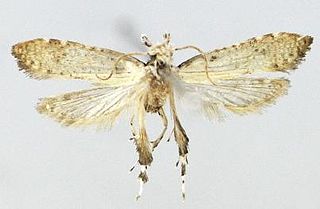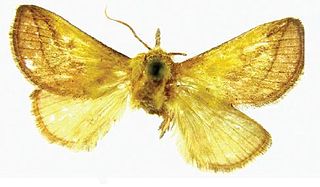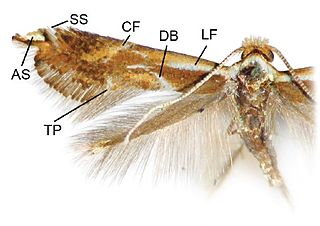
Graphium sarpedon, the common bluebottle or blue triangle in Australia, is a species of swallowtail butterfly that is found in East, South and Southeast Asia, as well as eastern Australia. There are approximately sixteen subspecies with differing geographical distributions.

Doleschallia bisaltide, the autumn leaf, is a nymphalid butterfly found in South Asia, Southeast Asia, and Australasia. In Australia it is also known as the leafwing.

Cucullia chamomillae, the chamomile shark, is a moth of the family Noctuidae. The species was first described by Michael Denis and Ignaz Schiffermüller in 1775. It is found in Central Europe, Southern Europe, the Near East and North Africa.

Morophaga choragella is a moth of the family Tineidae. It is found in Europe.

Bembecia ichneumoniformis, the six-belted clearwing, is a moth of the family Sesiidae.

Isodemis quadrata is a moth of the family Tortricidae. It is known from Tibet, China.
Lambertiodes multipunctata is a moth of the family Tortricidae. It is found in China.

Tinissa is a genus of the fungus moth family (Tineidae). Therein, it belongs to the subfamily Scardiinae.

Tinissa conchata is a moth of the family Tineidae. It is found in China.

Tinissa connata is a moth of the family Tineidae. It is found in China.

Tinissa leguminella is a moth of the family Tineidae. It is found in Yunnan, China.

Tinissa spirella is a moth of the family Tineidae. It is found in Sichuan, China.

Thisizima fasciaria is a moth of the family Tineidae. It is found in China.

Thisizima subceratella is a moth of the family Tineidae. It is found in China.

Monema tanaognatha is a moth of the family Limacodidae. It is found in China.

Halolaguna discoidea is a moth in the family Lecithoceridae. It is found in China.

Philonome cuprescens is a species of moth of the family Tineidae. It is found in Mexico (Guerrero).

Philonome lambdagrapha is a species of moth of the family Tineidae. It is found in French Guiana.

Philonome curvilineata is a species of moth of the family Tineidae. It is found in French Guiana.

Amphixystis cymataula is a moth of the family Tineidae. It was described by Edward Meyrick in 1909 and is found in Zimbabwe.

















